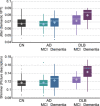Speech and language characteristics differentiate Alzheimer's disease and dementia with Lewy bodies
- PMID: 36320609
- PMCID: PMC9614050
- DOI: 10.1002/dad2.12364
Speech and language characteristics differentiate Alzheimer's disease and dementia with Lewy bodies
Abstract
Introduction: Early differential diagnosis of Alzheimer's disease (AD) and dementia with Lewy bodies (DLB) is important, but it remains challenging. Different profiles of speech and language impairments between AD and DLB have been suggested, but direct comparisons have not been investigated.
Methods: We collected speech responses from 121 older adults comprising AD, DLB, and cognitively normal (CN) groups and investigated their acoustic, prosodic, and linguistic features.
Results: The AD group showed larger differences from the CN group than the DLB group in linguistic features, while the DLB group showed larger differences in prosodic and acoustic features. Machine-learning classifiers using these speech features achieved 87.0% accuracy for AD versus CN, 93.2% for DLB versus CN, and 87.4% for AD versus DLB.
Discussion: Our findings indicate the discriminative differences in speech features in AD and DLB and the feasibility of using these features in combination as a screening tool for identifying/differentiating AD and DLB.
Keywords: acoustic; digital health; language impairment; linguistic; machine learning; natural language processing; prosodic; spontaneous speech.
© 2022 The Authors. Alzheimer's & Dementia: Diagnosis, Assessment & Disease Monitoring published by Wiley Periodicals, LLC on behalf of Alzheimer's Association.
Conflict of interest statement
YY is employed by the IBM Corporation.KS is employed by the IBM Corporation.MN received funding from the Japan Society for the Promotion of Science, KAKENHI (grant number 19H01084).MO has nothing to disclose.KN has nothing to disclose.TA received funding from Japan Society for the Promotion of Science, KAKENHI (grant number 19H01084). TA reports honoraria for lectures from Eisai, Daiichi‐Sankyo, and Sumitomo Pharma. Author disclosures are available in the Supporting Information.
Figures


Similar articles
-
Characteristics of Drawing Process Differentiate Alzheimer's Disease and Dementia with Lewy Bodies.J Alzheimers Dis. 2022;90(2):693-704. doi: 10.3233/JAD-220546. J Alzheimers Dis. 2022. PMID: 36155515 Free PMC article.
-
[Narrative discourse in dementia with Lewy bodies and Alzheimer's disease].Geriatr Psychol Neuropsychiatr Vieil. 2019 Jun 1;17(2):199-210. doi: 10.1684/pnv.2019.0798. Geriatr Psychol Neuropsychiatr Vieil. 2019. PMID: 31162120 French.
-
Natural speech markers of Alzheimer's disease co-pathology in Lewy body dementias.Parkinsonism Relat Disord. 2022 Sep;102:94-100. doi: 10.1016/j.parkreldis.2022.07.023. Epub 2022 Aug 6. Parkinsonism Relat Disord. 2022. PMID: 35985146 Free PMC article.
-
Dementia with Lewy bodies and Parkinson's disease-dementia: current concepts and controversies.J Neural Transm (Vienna). 2018 Apr;125(4):615-650. doi: 10.1007/s00702-017-1821-9. Epub 2017 Dec 8. J Neural Transm (Vienna). 2018. PMID: 29222591 Review.
-
Noninvasive automatic detection of Alzheimer's disease from spontaneous speech: a review.Front Aging Neurosci. 2023 Aug 24;15:1224723. doi: 10.3389/fnagi.2023.1224723. eCollection 2023. Front Aging Neurosci. 2023. PMID: 37693647 Free PMC article. Review.
Cited by
-
Digital Biomarkers for the Assessment of Non-Cognitive Symptoms in Patients with Dementia with Lewy Bodies: A Systematic Review.J Alzheimers Dis. 2024;100(2):431-451. doi: 10.3233/JAD-240327. J Alzheimers Dis. 2024. PMID: 38943394 Free PMC article.
-
High frequency post-pause word choices and task-dependent speech behavior characterize connected speech in individuals with mild cognitive impairment.medRxiv [Preprint]. 2024 Aug 16:2024.02.25.24303329. doi: 10.1101/2024.02.25.24303329. medRxiv. 2024. Update in: J Alzheimers Dis. 2024 Dec;102(3):815-829. doi: 10.1177/13872877241291239. PMID: 38464237 Free PMC article. Updated. Preprint.
-
Speech patterns during memory recall relates to early tau burden across adulthood.Alzheimers Dement. 2024 Apr;20(4):2552-2563. doi: 10.1002/alz.13731. Epub 2024 Feb 13. Alzheimers Dement. 2024. PMID: 38348772 Free PMC article.
-
Distinct eye movement patterns to complex scenes in Alzheimer's disease and Lewy body disease.Front Neurosci. 2024 Apr 5;18:1333894. doi: 10.3389/fnins.2024.1333894. eCollection 2024. Front Neurosci. 2024. PMID: 38646608 Free PMC article.
-
Clinical Decision Support Using Speech Signal Analysis: Systematic Scoping Review of Neurological Disorders.J Med Internet Res. 2025 Jan 13;27:e63004. doi: 10.2196/63004. J Med Internet Res. 2025. PMID: 39804693 Free PMC article.
References
-
- McKhann GM, Knopman DS, Chertkow H, et al. The diagnosis of dementia due to Alzheimer's disease: recommendations from the National Institute on Aging‐Alzheimer's Association workgroups on diagnostic guidelines for Alzheimer's disease. Alzheimers Dement. 2011;7(3):263‐269. 10.1016/j.jalz.2011.03.005 - DOI - PMC - PubMed
LinkOut - more resources
Full Text Sources
